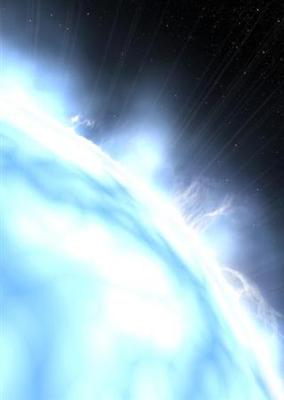
|
| ©REUTERS/M.S. Sliwinski and L. I. Slivinska of Lunarismaar/Handout |
| An artists' concept of the surface of the white dwarf star H1504+65, released to Reuters on November 21, 2007. |
White dwarfs mark the end point in stellar evolution for all but the most massive of stars in the universe, with about 97 percent of stars, including our sun, destined to finish their existence this way, according to astronomers.
White dwarfs result from the collapse of star cores in dying stars whose nuclear fusion has ceased. They usually have a mass about that of the sun, but are only a bit larger than Earth because they have blown off their outer layers, leaving behind only a small, dim and extremely dense core.
University of Arizona astrophysicist Patrick Dufour said previously known white dwarfs have fallen into two categories: those with a hydrogen-rich atmosphere and those with a helium-rich atmosphere. But Dufour and three other scientists, writing in the journal Nature, described eight white dwarfs that break the mold by possessing carbon atmospheres.
The researchers think they may have formed from stars much more massive than the sun but not quite massive enough to explode as a supernova.
"It was totally unexpected because all of the white dwarfs we knew so far were either hydrogen-rich or helium-rich. So this is a completely new kind of star," Dufour said in a telephone interview.
These eight white dwarfs are located in our own galaxy between about 1,000 and 2,000 light years from Earth, Dufour said. A light year is about 6 trillion miles, the distance light travels in a year.
The scientists have spotted at least a couple of other white dwarfs that might fit into this new category, Dufour added. All of them were among about 10,000 new white dwarfs recently identified in an extensive survey effort.
After blowing off their outer layers, white dwarfs typically leave behind a core of carbon and oxygen that is cloaked by a surrounding atmosphere of hydrogen or helium. The eight newly described ones have atmospheres primarily of carbon, with little or no trace of hydrogen or helium.
"It will be a challenge to try to explain how they form and what does this tell us about stellar evolution," Dufour said.
They might have evolved from a star similar to a unique one called H1504+65, the researchers said. Astronomers think this star violently expelled all its hydrogen and nearly all its helium, leaving behind a stellar nucleus with a surface half carbon and half oxygen.
(Editing by Vicki Allen)



Reader Comments
to our Newsletter